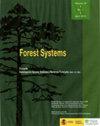水杨酸和柠檬酸在海松树脂开发中的应用前景
IF 0.7
4区 农林科学
Q3 FORESTRY
引用次数: 8
摘要
研究目的:我们测试了最广泛使用的含有硫酸的树脂敲击兴奋剂的替代活性成分。我们还用微型作图法研究了伤害对五年生松树幼苗的影响。研究领域:实验在西班牙马德里政治大学进行。材料和方法:实验由六个处理组成:对照(无刺激物,无损伤)、伤口(无刺激剂)和用硫酸、乙烯利、水杨酸和柠檬酸刺激的松树。我们评估了释放树脂和内部树脂(保留在木质部内的树脂)之间的树脂产量差异,以及树木的生理状况。主要结果:受伤植物产生的树脂平均是对照植物的三倍。水杨酸和柠檬酸刺激的植物表现出最高的树脂产量,产生的树脂比硫酸刺激的植物平均多15%,主要是因为释放的树脂更高。树木直径影响树脂产量,较厚的树木产生更多的树脂。我们没有观察到处理对气孔导度的任何显著影响,只有对水势的边际显著影响(p<0.10)。研究重点:水杨酸和柠檬酸似乎是树脂敲击活性的有希望的兴奋剂,有待于在成树的田间试验中进一步测试。关键词:硫酸;乙烯利;松树脂;微量绘图;伤人;水势;气孔导度。使用的缩写:TR:树脂总含量;RR:释放树脂;IR:内部树脂;gs:气孔导度;Ψ叶:午间叶水势。本文章由计算机程序翻译,如有差异,请以英文原文为准。
Salicylic and citric acid as promising new stimulants for resin tapping in maritime pine (Pinus pinaster Ait.)
Aim of the study: We tested alternative active principles to the most widely used resin tapping stimulant which contains sulphuric acid. We also studied the effect of wounding in five-year-old Pinus pinaster seedlings with a microtapping method.Area of study: The experiment was carried out at the Universidad Politécnica de Madrid in Spain.Material and Methods: The experiment consisted of six treatments: control (no stimulant no wounding), wound (no stimulant), and pines stimulated with sulphuric acid, ethrel, salicylic acid and citric acid. We evaluated the resin yield differentiating between released resin and internal resin (resin retained within the xylem), and the physiological status of the tree.Main Results: Wounded plants produced on average three times more resin than control plants. Plants stimulated with salicylic and citric acids showed the highest resin yield and produced on average 15% more resin than those stimulated with sulphuric acid, mainly because the released resin was higher. Tree diameter affected resin yield and thicker trees produced more resin. We did not observe any significant effect of the treatments on stomatal conductance and only a marginal significant effect (p<0.10) on water potential.Research highlights: Salicylic acid and citric acid seem to be promising stimulants for the resin tapping activity to be further tested in field experiments with adult trees.Keywords: sulphuric acid; ethrel; pine resin; microtapping; wounding; water potential; stomatal conductance.Abbreviations used: TR: total resin content; RR: released resin; IR: internal resin; gs: stomatal conductance; Ψleaf: midday leaf water potential.
求助全文
通过发布文献求助,成功后即可免费获取论文全文。
去求助
来源期刊

Forest Systems
FORESTRY-
CiteScore
1.40
自引率
14.30%
发文量
30
审稿时长
6-12 weeks
期刊介绍:
Forest Systems is an international peer-reviewed journal. The main aim of Forest Systems is to integrate multidisciplinary research with forest management in complex systems with different social and ecological background
 求助内容:
求助内容: 应助结果提醒方式:
应助结果提醒方式:


